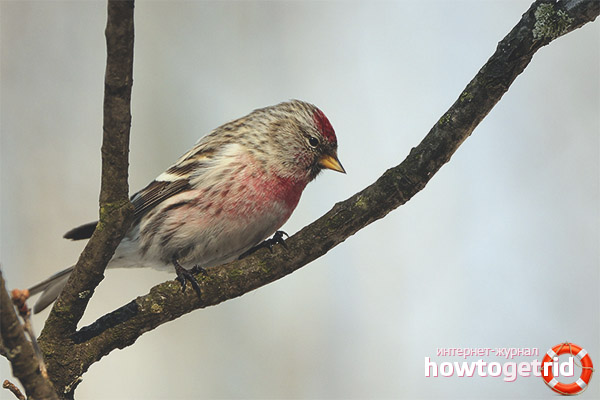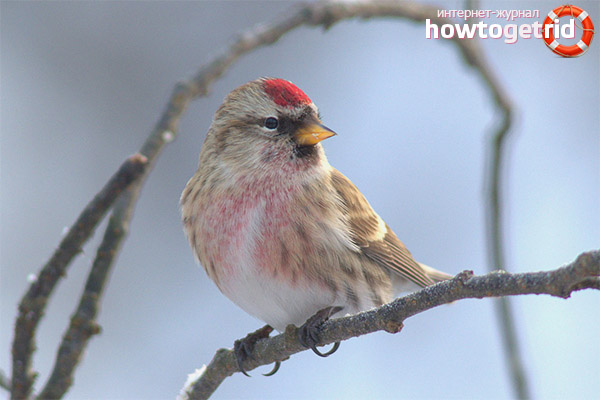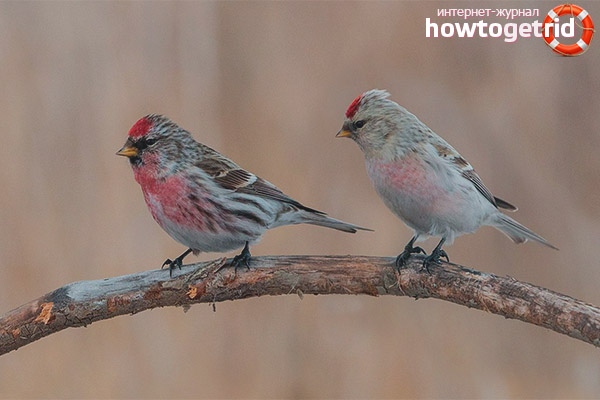The content of the article
Tap dance is a small bird that belongs to passerines. These birds got their name for the singing features. It is very similar to the sound made during tap dancing. Translation of the name of the bird from Latin - a fiery thorn. They got this name due to their external features. The plumage on their chest is red. This individual belongs to the genus Carduelis.
Description
This bird is very small. The body length barely reaches 15 cm. The adult bird has a wingspan of about 20 cm. It weighs only 15 g.
On the back of the males, the plumage is colored gray. In some individuals, it is lighter, almost white. The tap dance head is bright red. The beak is painted in a rich yellow hue. The plumage in the area of the suprahyposthesis of the representatives of this species is pink. But most of all, the coloring of the abdomen stands out. It’s crimson. Such a variety of bright colors makes the bird very attractive. But this description applies only to males. Female tap dance cannot boast such beauty. Red plumage they have only on the crown. All other parts of the body of the female are white.
You can distinguish a bird from other species by its unusual singing. It is very similar to the sound that is heard during tap dancing.
Habitat
Representatives of this species can be seen mainly in the northern latitudes. They live in Eurasia, as well as in North America. You can meet tap dance even in Greenland. There are also in Russia. The bird can be seen in the northern regions.
Favorite tap dance habitats are deciduous forests. In the summer they can often be seen walking in the taiga. They spend the winter in warmer places, flying away from the cold. There, they also choose a mixed forest as their home. These birds are not afraid to approach a person, so sometimes they can be seen in cities or villages.
Lifestyle
As soon as the flock feels any threat, the birds immediately take off, breaking off the branch. But when they are convinced that the danger has passed, they can immediately return to their place, continuing to do their own thing.
They build a nest high on a tree. The bird chooses a place around which there are thickets that can mask the nest well. Therefore, it is very difficult to detect.
Sometimes these birds are kept at home. The striking appearance of the tap dance attracts people. The bird quickly gets used to the new conditions. Tap dance, although small and beautiful, its singing is too monotonous, and can quickly get bored. For this reason, keeping these birds at home is not very common.
Food

These birds feed very diverse. The diet includes both plant and animal components. From plant foods, tree seeds are their favorite treat. They eat birch catkins, can eat spruce or lingonberry seeds.
Favorite insects for tap dance are aphids.But they can also feed on many other types of insects that they come across in search of food.
If you still want to keep tap dance at home, it is recommended to feed it with special feeds that are designed for canaries. You can not overfeed them. Otherwise, the tap dance will gain weight. This will reduce the life expectancy of birds.
Breeding
The breeding season of these birds begins in early spring, when the snow has not even melted yet. During this period, males are particularly active. To attract a female, they begin to fly very quickly in a circle and constantly sing. In addition, the red plumage becomes even brighter.
When the female responds to these actions, a pair is formed. They immediately begin arranging the nest. Most often they place it in the bushes. In one clutch, usually 6 eggs. They have a green tint, and are covered with dark spots.
The female is engaged in hatching. The period lasts about 14 days. The male at this time takes care, bringing food to the female.
After the birth, chicks of tap dance remain in the nest for about 2 weeks. After that, they make their first flight attempts. Then the chicks learn to seek food for themselves. When all these skills are mastered, young individuals fly away from the parental nest. When they fly away, parents immediately begin to create another generation. During the year they give offspring twice.
Young individuals who have just left the nest live the same way as adult birds.
Content
Bird lovers rarely see tap dance. Although it is not difficult to care for them. Low popularity is associated with the monotonous song of the bird. But the appearance attracts a lot of people.
It is recommended to contain together with carduelis or siskins. In this combination, it will be very interesting to watch the birds. When kept in an aviary or garden, sometimes you can get offspring tap dance. Amateurs cross them with other representatives of finch or canaries. But at the same time, it is important to remember that in order to obtain successful offspring it is necessary that the couple consist of a female tap dance and a kenar. Otherwise, the chicks will die before they hatch, or shortly after appearing. Very beautiful chicks are obtained by crossing with a red kenar. On the chest, the birds will have a bright color, and on the head - a hat. They will sing briskly.
Interesting Facts
- The average life expectancy of representatives of this species of birds depends on the conditions in which they lived. During normal life in the wild, tap dance lives for about 6-8 years. But sometimes they can live longer. At home, the bird lives longer. If you follow all the rules for care and nutritional recommendations, tap dance can live in a cage for about 10 years.
- These birds are distinguished by their courage. They are not at all afraid of people. They can live very close to houses. In winter, birds can often be seen in the park, where they seek food for themselves.
- Since the bird is very small, it is often a victim of predators. But this fact does not make them timid. Rosettes still fly wherever they want, without fear of anything.
- Back in Tsarist Russia, tap dancing was a favorite bird among representatives of the nobility. Near the royal palace lived 200-300 of these birds.
- They are so fearless that a person can calmly approach the nest. In this case, the bird will not show any anxiety. This feature distinguishes tap dance from many others. If a person approaches the nest for several days, the brave bird will get so used to it that it can even be stroked.
Video: tap dance (Carduelis flammea)











Submit